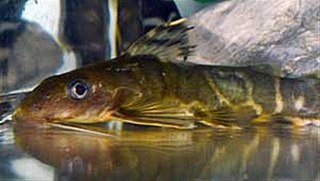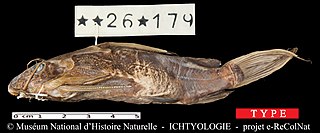
Synodontis is the largest genus of mochokid catfishes. It is the biggest genus within the 10 genera and 190 different species in the family Mochokidae. Synodontis has over 131 different species within the genus. Synodontis are also known as squeakers, due to their ability to make stridulatory sounds through their pectoral fin spines when handled or disturbed. Synodontis make a sound that sounds like squeaking by rubbing their spines together. They do this when they have been frightened or when they become angry. Synodontis may also squeak when they are taken out of the water. These catfish are small- to medium-sized fish with many species exhibiting attractive spotted markings. Some species are also known for naturally swimming belly-up, earning the name upside-down catfish. Some of these species are Synodontis contractus and Synodontis nigriventris. While some of these species are known to swim upside down, another species, Synodontis multipunctatus, is a brood parasitic cuckoo catfish,there are two other species Synodontis petricola and Synodontis grandiops are also called brood parasitic cuckoo catfish.

Amphilius is a genus of catfishes of the family Amphiliidae.

Phractura is a genus of loach catfishes that occur in Africa.
Zaireichthys is a genus of loach catfishes of the family Amphiliidae.

Microsynodontis is a genus of upside-down catfishes native to freshwater rivers in western Africa. The genus was originally described by British-Belgian zoologist George Albert Boulenger in 1903 based upon the type species Microsynodontis batesii. The name microsynodontis comes from the Greek word mikro, meaning small, and the Greek term synodon, meaning "with the teeth all growing together".
Microsynodontis nasutus is a species of upside-down catfish endemic to Gabon where it occurs in the Ogowe River. It was first described in 2004 by Ng Heok Hee.
Synodontis aterrimus, known as the network synodontis, is a species of upside-down catfish that is endemic to the Democratic Republic of the Congo where it is found in the middle Congo Basin. It was first described by Max Poll and Tyson R. Roberts in 1968. The original specimens were obtained in Bokuma, on the Congo River in what is now the Democratic Republic of the Congo. The species name aterrimus means "very black", referring to the dark coloration on the underside of the body.

Synodontis brichardi, known as Brichard's synodontis, is a species of upside-down catfish that is endemic to the Democratic Republic of the Congo where it occurs in the rapids of the lower Congo River. It was first described by Max Poll in 1959. The original specimens were obtained from the rapids at Kinsuka, Kinshaa, Zaire. The species name brichardi is named in honor of Pierre Brichard, an aquarium fish exporter who first discovered the fish.

Synodontis centralis is a species of upside-down catfish that is endemic to the Democratic Republic of the Congo where it occurs in the middle Congo Basin. It was first described by Max Poll in 1971. The original specimens were obtained in Ndwa village, Kunungu, Zaire. The species name centralis refers to its habitat in the central Congo Basin.
Synodontis dorsomaculatus is a species of upside-down catfish that is endemic to the Democratic Republic of the Congo where it occurs in the Lukusi and upper Lualaba Rivers and the Upemba lakes. It was first described by Max Poll in 1971. The original specimens were obtained in Kadia, Kisale, Katanga, in what is now the Democratic Republic of the Congo. The species name dorsomaculatus is derived from the word dorso, meaning "back", and the word maculatus, meaning "spotted", a reference to the dark round spots on the fish's back.

Synodontis leopardinus, known as the leopard squeaker, is a species of upside-down catfish that is native to the Cunene, Okavango and upper Zambezi Rivers. It was first described by Jacques Pellegrin in 1914. The original specimens were obtained in Barotsés, on the Zambezi River in Zambia. The species name leopardinus means "leopard like", referring to the fish's small black spots on a yellowish body.
Synodontis longispinis is a species of upside-down catfish that is endemic to the Republic of the Congo where it is found in the Sangha River. It was first described by Jacques Pellegrin in 1930 as Synodontis batesi longspinis, a subspecies of S. batesi with an especially long dorsal fin spine, but it is presently recognized as its own species. The species name longispinis is derived from the word longus, meaning long, and the word spinis, meaning spine, which is a reference to the long dorsal fin spine on the fish.
Synodontis lufirae is a species of upside-down catfish that is endemic to the Democratic Republic of the Congo where it occurs in the Lufira River drainage. It was first described by Max Poll in 1971. The original specimens were obtained in the Lufira River, in the Congo River Basin. The species name lufirae is named for the river in which the species is found.
Chiloglanis kazumbei is a species of upside-down catfish found in Tanzania, where it occurs in the lower Malagarasi River and the Luiche River; it has also been seen in affluents of Malagarazi in Burundi. This species grows to a length of 5.4 centimetres (2.1 in) SL.
Chiloglanis igamba is a species of upside-down catfish that occurs in Tanzania's Malagarasi River, to which it is probably endemic. This species grows to a length of 6.5 centimetres (2.6 in) SL.
Chiloglanis orthodontus is a species of upside-down catfish that occurs in several greatly separated sites in the lower Malagarasi River in Tanzania, and is likely endemic to the basin. This species grows to a length of 2.9 centimetres (1.1 in) SL.

Enteromius is a genus of small to medium-sized cyprinid fish native to tropical Africa. Most species were placed in the genus Barbus.
Chiloglanis frodobagginsi is a species of catfish native to West Africa, in particularly the upper Niger River. First described in 2023, it was initially mistaken for its sister species, Chiloglanis micropogon.
Chiloglanis fortuitus is a species of catfish native to West Africa, specifically rivers in Liberia. It was first described in 2023, alongside another species of Chiloglanis, Chiloglanis frodobagginsi.
Chiloglanis devosi is a species of catfish native to Africa, in particularly rivers in Kenya. The species was first described in 2015, alongside Chiloglanis kerioensis. It was named after Luc De Vos, who had served as the director of the Ichthyology Section of the National Museums of Kenya.








